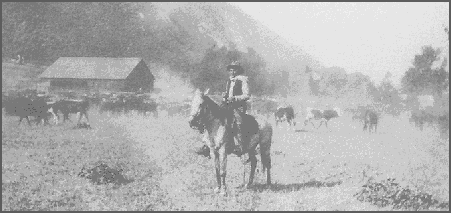Riding Out the Civil War
Lane Gets New Nieghbors
In the spring of 1863 a new family of desert settlers took up temporary residence at Lane's. At that time, according to a sworn statement by Deputy Assessor Sydney Waite, a Mr. E. P. Prothero was living on the Mojave River in improvements on public land claimed by Aaron Lane. Edward Powell Prothero was a Welshman who, after converting to Mormonism, emigrated first to Utah and then to San Bernardino. The added security provided by Prothero and his family was a blessing, especially since he had two of his adult sons, John and James, still living with him.The stay was a brief one, however, as the Protheros soon finished construction of their own homes at the Cottonwoods. The following year Edward and his son, John, are shown in the Auditor's Assessment Book as each having improvements on state land at the Cottonwoods.
In 1864 a cattle concern moved in near Aaron. They had a large herd with attendant cowboys -- always good neighbors to have if there is trouble with the Indians.
The herd had been moved to the Mojave as the result of a long drought which had devastated the prominent ranchers in Southern California. The drought had started back in the late 1850s, and by 1862 the ranchers had begun losing their cattle to starvation. This is one of nature's ironies: in the midst of one of the worst droughts in Southern California history, there occurred the greatest storm.
One of the stockmen, William Wolfskill, whose familiarity with the Spanish Trail extended back to 1830, had traveled the Mojave River valley in the summer of 1863 on his way to Tonopah to look after some mining interests. He noticed the verdant grasses were growing well despite the lack of rain, and determined to bring his cattle here if the drought continued.
The dry weather persisted and by January of 1864 many of the ranch animals looked like skeletons, and large numbers were dying. Some ranchers had already lost half their stock, and it was feared that many more would be lost. The decision was made to move the cattle to the desert, thus a camp was established near Lane's.

Early 20th Century photograph
HERDING CATTLE IN THE UPPER MOJAVE RIVER AREA
J. E. Pleasants, one of the cowhands employed by William Wolfskill, later wrote a story of the drive, which appeared in the March 1930 issue of Touring Topics. He writes that beginning in January 1864 the ranchers organized a cattle drive to the Mojave, made up of around 3,000 head plus several hundred horses. The herd was moved about 500 head at a time, traveling only 15 miles a day due to the condition of the stock.
After resting a few days in San Bernardino, the drovers entered Cajon Pass, where they encountered sleet storms and very cold winds, and often there were icicles hanging from the horses' bridle bits. The herd survived the inclement weather in the pass, for the most part, and by the end of March they were settled on the Mojave.
Pleasants mentions that rancher John Rowland also had cattle in the drive. Rowland, according to Pleasants, was Wolfskill’s partner in the Rancho La Puente, although they kept separate brands.
Pleasants speaks well of Aaron Lane, but with the intervening 66 years since the cattle drive, he recalls him as "John" Lane:
-
Our neighbor on the Mojave was John Lane of Lane's Crossing, a trading post which he kept at the first crossing of the
Mojave River.... John Lane was a true frontiersman and a genial host, and many a tale of hair-breadth escapes and desert hardship
has doubtless been told by the campfires of the emigrant and teamster under the cottonwoods.
Besides the freighting traffic, Pleasants states, there was still considerable immigration from the East along the Salt Lake Road. All this bustle kept the cowboys on the Mojave River from getting too lonely.
This cattle outfit was very well run. The cowhands even managed a wary truce with the local Indians. There had been many Indians around the camp, but the cowboys always supplied them with beef whenever they needed it, and relations were good. The drovers knew the desert Indians could be treacherous, but sympathized with the conditions under which they had to survive, subsisting mostly on rabbits, rats, insects and mesquite beans, when they were lucky enough to get them.
The Indians gave Pleasants quite a scare one morning when he and a companion were out scouting the desert. The two men were confronted by about 20 Indians who wanted tobacco, but the cattlemen had not taken up the habit, so they were unable to satisfy their demands.
The Indians became hostile and insolent, and actually searched the cowhands and their gear, thinking they were lying about not having any tobacco. When they failed to find any, the Indians turned sullen and went away muttering, "No tobacco smokum; no good hombres."
On November 16, 1864, steady rains began that continued throughout the winter season, and the terrible drought was broken. In April of 1865 the ranchers began to take the cattle back home, and all were returned by the middle of May. The ranchers lost 25 percent of their stock in the move to the desert, but the loss was 75 percent for those who did not come. Pleasants goes on to say that the losses to the cattle industry, which was predominant in California prior to 1864, were so great that it never recovered, and many fortunes, large and small, were gone forever.
By the fall of 1864, new residents had moved even further down the river than the Nicholson and Prothero families, who were still at Point of Rocks and Cottonwoods. Albert Jacoby had moved to Grape Vines, and the Alcorn family was living at Forks of the Road.
< Previous - Next >
-=-